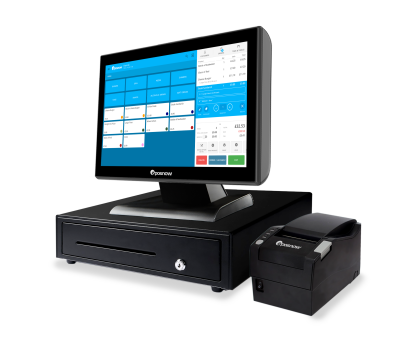Restaurant Operations Management: Learn The Key Areas & Tips
We all know that running a restaurant is more than just serving up drool-worthy dishes (though, yes, that’s a big part of it). The real magic happens behind the scenes.
Restaurant owners or restaurant managers know that their superpower is keeping those daily operations running smoother than a freshly polished countertop. You’ve got to be on top of every little detail like a hawk with a clipboard (or, you know, just a really good manager.) Nail the processes behind restaurant operations management, and you’ll be serving up not just great food but a killer dining experience that keeps the customers coming back for more.
So, what exactly is this whole “restaurant operations management” thing, you ask? (Good question, by the way.) It’s basically a fancy term for all the behind-the-scenes stuff that keeps your restaurant humming. This guide is going to spill all the tea on what goes into managing restaurant operations like a pro, and—most importantly—how to make it all better, faster, and more profitable. Let's get started.
Restaurant operations goals
Restaurant operations management is all about making sure your restaurant is not just running, but thriving. You want to boost efficiency and squash any problem areas before they can turn into full-blown disasters.
So, let’s talk goals. What exactly are restaurant managers focusing on when they’re trying to level up restaurant operations at their restaurant business? Glad you asked! Here’s Some operations manager duties:
-
Keeping inventory on point: Inventory management (also known as inventory control) is a biggie. You don’t want to run out of avocados mid-brunch rush (the Gen Zs and millennials will freak out), but you also don’t want a storeroom full of wilting lettuce. A point of sale system can help here, giving you real-time updates.
-
Nailing food safety: Because “extra crunchy” should never apply to a surprise in your soup. Just saying.
-
Serving up great quality: The only thing better than good food is consistent good food. Your famous lasagna should taste like heaven every time.
-
Customer satisfaction: Happy customers are repeat customers, and word of mouth is still the best marketing. Plus, with 2.4 billion people on Insta alone, everyone's a critic nowadays so try to handle any complaint well. Customer complaints can be a killer if they're brought to the review pages.
-
Watching those dollars: Keeping an eye on the financial health and profit margins of your restaurant is super important. Good accounting programs can help with this.
-
Streamlining prep time: Looking for functional areas for a restaurant revamp is key here. Faster prep means happier customers and less stress when it comes to kitchen operations. As a restaurant operations manager, you ensure things are happening quickly and efficiently.
-
Training the newbies: As a restaurant owner, you need a solid training program for new hires because it means less chaos and more consistency. They need to know how day to day operations work, how to upsell sales trends, menu planning and how to streamlining operations.
-
Managing staff like a pro: Great teams make for great service.
So, there you have it—the insider’s guide to the goals of operations management in the restaurant business world.
6 Tips to enhance operations management in your restaurant
Now that you’re clued in on all the moving parts of restaurant operations management, it’s time to roll up those sleeves and get down to business. Let’s talk about how to improve restaurant operations management. Here are six winning tips to take your restaurant from “just getting by” to “crushing it”:
1. Set a clear operational plan
A lot has to go right for your restaurant to swing open its doors each day, everything from taking orders and prepping food to setting up the dining area, running staff meetings, and ordering tomorrow's supplies. Not to mention finding that one missing spatula that always seems to vanish! That’s why having a clear operational plan (AKA a restaurant operations management strategy) for every little task is really important.
Without these plans, things can quickly go off the rails. Your team might start missing critical steps, like forgetting to reorder that all-important ingredient or neglecting a deep clean. And if those kind of issues sticks around long enough, trust us, your customers will notice.
So, to keep things running smoothly, make sure you’ve got a plan for every scenario—no matter how big or small. Here are some actionable planning tips to get you started:
-
Create a daily task checklist: Outline every task that needs to be completed each day in a restaurant management and operations checklist. From opening duties to closing protocols and problem solving methods. This keeps everyone on track and ensures nothing gets overlooked.
-
Assign clear responsibilities: Make sure every team member knows exactly what their role is and what tasks they’re responsible for. No more “I thought you were doing that!” moments.
-
Develop Standard Operating Procedures (SOPs): For each key task, create a step-by-step guide that details how it should be done. This helps maintain consistency and quality, even when you have new staff or when things get hectic.
-
Schedule regular team meetings: Set up daily or weekly meetings to review the day’s plan, address any concerns, and keep everyone on the same page. It’s also a great time to share feedback and celebrate wins!
-
Use technology to your advantage: Invest in tools like a restaurant POS system with restaurant management software, scheduling apps, and order tracking systems. These tools can help automate repetitive tasks, reduce errors, and free up your team to focus on more important things.
-
Plan for the unexpected: Have contingency plans in place for common disruptions, like sudden staff shortages or supply chain issues. Being prepared means you can handle any curveballs.
2. Streamline ordering and payments
If you want things to run like clockwork, you’ve got to make it as easy as possible for your customers to place orders and settle up.
First up, the ordering process. Ditch the old-school pen and paper and get yourself a slick digital ordering system. Not only does it cut down on errors (no more “I asked for no pickles!”), but it also speeds things up for both your staff and your customers.
Now, onto payments. The quicker and smoother, the better. Find a payment processing provider that's reliable, secure, and offers multiple payment options like contactless payments, mobile wallets, pay by link and even good old-fashioned card swiping. Make it so easy that customers barely have to lift a finger—just a quick tap and they’re done.
And hey, while you're at it, consider integrating everything into one system—ordering, payments, even customer loyalty into one cloud-based restaurant POS system.
The bottom line is, the easier and faster the process, the happier your customers will be.
3. Regular staff training to increase team efficiency
Another big part of efficient restaurant operations management is training. If you want your restaurant to run perfectly (or at least like a kitchen where the head chef isn’t yelling every five minutes), then regular staff training is non-negotiable. Think of it as a little tune-up for your team.
Training isn't just about making sure your staff knows the menu front to back (though, yes, that’s important). It’s also about building a crew that works together seamlessly, like a dance troupe during a perfectly choreographed number. Minus the jazz hands. Unless that’s your thing.
Make training sessions fun and interactive—nobody wants to sit through a snooze-fest lecture. Use real-life scenarios, role-playing, and maybe even a little friendly competition to keep everyone engaged. Got a star server who’s mastered the art of upselling? Have them share their secrets with the team.
And don’t just train once and call it a day. Make it a regular thing—weekly, monthly, whatever works for you. The key is to keep everyone sharp and on their toes. Plus, it’s a great way to introduce new policies or menu items without causing mass confusion.
4. Automate inventory management to control food costs
Automating your inventory management is like having a personal assistant who never takes a day off. With the right point of sale software, you can keep tabs on everything related to inventory levels, from how much chicken you have left to when it’s time to reorder that secret sauce that everyone loves. No more guessing games.
Plus, an automated system can alert you to any discrepancies. If someone’s been a little too generous with the Parmesan (hey, it happens), you’ll know about it. That means less waste and more control over your food costs. Because let’s face it, every penny counts when you’re running a restaurant.
5. Use real-time data analytics to improve decision-making processes
Ever wondered which menu items are your top sellers and which are just taking up space? Or how about figuring out when your busiest times are so you can have the right staff on hand? And what about spotting inventory issues before they become full-blown crises?
Real-time data analytics is your answer to these burning questions and more. With a POS system, you can generate a number of reports including:
-
Sales reports
-
Traffic patterns
-
Inventory reports
-
Customer trends
6. Leverage technological tools to enhance operational capacity
Technology tools can help streamline operations, reduce friction points in your restaurant and give you the time to make informed decisions.
If you implement an easy-to-use reservation system, for example, customers can book their tables ahead of time, reducing wait times and allowing your team to plan accordingly.
By following these tips, you’ll set up a smooth and efficient restaurant management system that boosts customer satisfaction and drives business growth.

Gain all the advantages of a POS system with detailed, flexible, downloadable reports, and so much more.
Software Hardware
Trends to be aware of in the current restaurant operational space
Restaurants are like the world’s fastest roller coaster—always moving, always changing. To keep up and stay ahead, it’s crucial to get a handle on the latest trends in restaurant operations. Here’s a rundown of what’s hot right now:
Takeout and delivery operations are increasing
Takeout and delivery aren’t just add-ons anymore, they’re a necessity. With 60% of US consumers ordering delivery or takeout at least once a week, it’s clear there’s a massive market just waiting for you to tap into. Make sure your online ordering game is strong.
Epos Now Delivery is a game-changer here. It’s designed to streamline the process, making it easy for customers to place their orders and for you to manage them efficiently.
Sustainability practices to reduce food waste
One-third of all food produced globally is lost or wasted between farm and fork—that’s over 1 billion tonnes. To put it in perspective, this amounts to 24% of the world’s food supply going uneaten, while 1 in 10 people still struggle with malnutrition.
This colossal scale of food waste isn’t just a waste of good grub. Nope, it’s a major hit to our wallets and the planet. Wasted food costs the global economy over $1 trillion every year and is responsible for 8%-10% of global greenhouse gas emissions.
So, what can you do in your restaurant to fight this? Here are some savvy sustainability practices:
-
Track inventory smartly: Use technology to keep a close eye on your stock levels and expiration dates. Tools like our EPOS solution can help you manage inventory efficiently, reducing the chances of over-ordering and spoilage.
-
Portion control: Be mindful of portion sizes. Offering adjustable portions or allowing customers to choose their own can help reduce food left on plates.
-
Repurpose leftovers: Get creative with how you use leftover ingredients. Day-old bread can turn into croutons, and overripe fruits can become smoothies or desserts.
-
Educate your team: Train your staff on the importance of reducing waste and how to handle food properly. A little awareness can go a long way in minimizing waste from prep to plate.
-
Engage with customers: Let your diners know about your sustainability efforts. Sometimes a little nudge can inspire them to be more mindful of their own waste, especially if they know it’s making a difference.
Personalized restaurant experiences to retain customers
People love feeling special, and a personalized experience can turn an ordinary meal into a memorable one. Here’s how you can make your restaurant the place everyone wants to come back to:
-
Know your guests: Use your reservation system or CRM tools to track customer preferences and past visits. Remembering if they prefer their steak medium-rare or their coffee with an extra shot of espresso can make them feel like a VIP every time they walk in.
-
Tailor your offerings: Offer custom menu options based on previous orders or special requests. If a guest frequently orders a certain dish, let them know if you have a new twist on it or a special version coming up.
-
Celebrate special occasions: Make birthdays, anniversaries, or any special celebration even more memorable. A complimentary dessert or a special shout-out from the staff can make your guests feel cherished.
-
Engage on social media: Use social media to connect with your diners. Share behind-the-scenes peeks, ask for feedback, and even celebrate milestones with your patrons
How Epos Now POS system can transform your restaurant
Elevate your restaurant operations with the Epos Now POS system. It integrates with hundreds of apps, including popular order and delivery platforms like Uber Eats and Grubhub, so you can streamline online orders effortlessly. Real-time inventory management ensures you never run out of key ingredients or overstock, while efficient payment processing keeps transactions quick and smooth.
Plus, with advanced hardware like the Kitchen Display System (KDS), orders go straight to the kitchen, reducing errors and speeding up service. Epos Now ties it all together, making your restaurant run like a well-oiled machine.
FAQs
- What are the 4 areas of responsibilities of an operations manager?
-
Managing inventory, ensuring food safety, keeping up food excellent, and maintaining quality restaurant customer service. This will make for successful restaurant operations management.
- What should be in a restaurant operations manual?
-
Policies and procedures, staff roles, safety protocols, inventory management, employee training schedules, common answers to customer inquiries, and emergency procedures.
- What is operational efficiency in a restaurant?
-
It’s all properly managing operations smoothly and profitably, optimizing processes to save time, reduce waste, and boost service quality.




